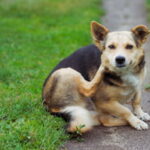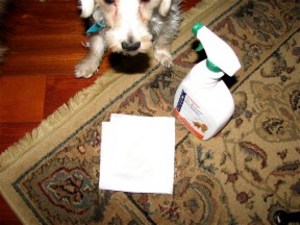Cat and dog pets have territorial tendencies which means that they will stake out a claim to a particular area or an object that they consider their own. There are many ways in which they stake this claim to the territory they perceive as their own. They usually do this by urinating and rarely defecating on certain spots or objects. Alternately, a dog may bark when any intruder enters its space and a cat may mark by rubbing its face over something. Many times urine marking is confused with house soiling and such confusion may prevent the use of appropriate behavior correction techniques. The animal may even become aggressive towards an unwelcome intruder.
Cats and dogs usually urine mark by spraying a little urine on vertical surfaces although they may do so on horizontal surfaces also. The pet usually lifts one leg while urine marking, but it may also sometimes do so without using this posture. It is urine marking and not soiling if the pet urinates on new items that have entered its territorial space. They may also mark by urinating on things that have a new type of smell or carry the smell of another animal. Spay and neutered pets are less likely to urine mark than the intact ones. However, even spay and neutered pets will do so in reaction to other pets in the house. Dogs may resort to urine marking to reestablish their dominance when their position in the family, they consider as their pack, is threatened. A cat may do so out of anxiety on being bullied by another cat. In some cases your pet may resort to urine marking when it sees another animal outside. This can also happen if your pet has been in contact with animals outside.
The best way to handle the problem is to get your pet spay and neutered at the earliest. Usually this will prevent urine marking but if the pet has been in the habit of urine marking for long then it may continue to do so. Another way to handle the problem of urine marking is to resolve any conflicts that exist between the pets in your home, because these unresolved conflicts could make a pet to urine mark frequently. Where the problem arises due to contact with other animals outside it is advisable to keep your pet away from doors and windows overlooking the outside. You can also try to keep other animals from near your home. Cats kept indoors are less likely to show marking behavior. Pets tend to urine mark on soiled areas. Hence you must thoroughly clean soiled areas regularly. Pets will urine mark spots where they can detect strong odors. Hence avoid using strong smelling cleaners like ammonia, as the pet will tend to overmark the spot by urine marking it. A pet will avoid urine marking an area where it plays or feeds. If can’t prevent your pet from marking a particular area then try feeding, treating or playing with it in that area.
To control your pet you must establish a dominance hierarchy in your home so that the dog realizes and accepts the fact that you are firmly in control. Don’t allow the pet to establish dominance over you. Your pet will learn to defer to you if it realizes that it will get its treat, petting, the toy or food when it behaves. This will firmly place you above your pet in its pack hierarchy. This will help you to control its marking behavior. Always keep objects that your pet tends to mark away from its reach. If you have a new baby in the house you can condition your pet by making sure that only nice things happen when the baby is around. Try to anticipate when your dog is about to urinate and divert its attention by making a loud noise and take it away from the spot and reward it when it urinates outside. In the case of cats when it begins to sniff the spot where it had marked earlier squirt a little water over the cat or make a loud noise. Make sure that your pet associates the unpleasant experience with its marking tendency.
Marking by pets may be due to dominance behavior as well as anxiety. Pets usually get anxious when they encounter new sights, sounds and smells in the environment and this can trigger urine-marking behavior. Closely observe the behavior of your cat and dog and see if you can discern a pattern in their urine marking behavior. If you can anticipate an incident you can prevent it by diverting the pet’s attention or trying to lower its anxiety.




